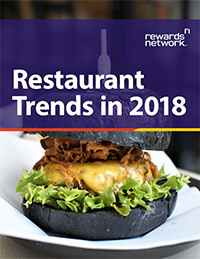2018 is looking like an interesting year for restaurant trends that could affect your bottom line.
Are you prepared for it?
In our brand new report, we take an in-depth look at what this year is going to be like for restaurants, both large and small, including:
- The state of the restaurant industry overall
- What’s hot in new restaurant menu trends
- Operational opportunities or challenges
Download this free eBook today to see what challenges 2018 has in store for your sales, and how to capitalize on the year’s restaurant trends, too.
Excerpt from Chapter 1:
As restaurant trends go, 2018 is looking to be much like its predecessor, at least in terms of industry growth and financial forecast. The consumer price index remains strong, with discretionary income stable, maybe even ticking up.
Earlier in the year, revenue for the restaurant industry was estimated to reach $799 billion by the end of 2017, up 4.3 percent from the previous year. That overall number, however, is deceptively high, and deflates to 1.7 percent growth when accounting for inflation. Those numbers break down further with $263 billion (3.5 percent growth) ascribed to full service establishments and $234 billion to quick service and fast casual (an impressive 5.3 percent growth).
However, the revised projection for the industry based on current performance is not meeting that 2017 forecast. Although new growth is expected in some segments with the opening of new stores and menu price adjustments, same store sales continue to remain a challenge with a reported rolling three months average of -1.1 percent for comparable sales and -3.2 percent for comparable traffic.
And with industry observers predicting macroeconomic indicators — unemployment level, disposable income — remaining largely unchanged or edged up only slightly, any period of rapid economic growth is expected to be out of reach in the next year.
In short, we’re looking at nearly flat growth for the restaurant industry as a whole in 2018.
With the prediction of a flat overall industry, one thing is absolutely certain: competition for where dollars are being spent is tight. Conventional wisdom dictates that if one dining establishment (or segment, such as fast casual) in a local market is doing substantially well in an environment as described above, it’s because customer business is shifting away from another one. Expectations are at an all-time high, but also, consumer behavior is simply changing. And that can have a profound effect on which establishments flourish.
Overall the hardest hit so far, restaurant chains have scaled back plans to expand over the course of the year. Red Robin has responded to disappointing late 2017 sales with a pause on unit growth as of year-end 2018 — inciting some poor stock activity as a result of the announcement. Famous Dave’s is down 13 units going into 2018 with focus shifting to more franchise units (and thus shared financial burden).
Similarly, by the end of the third quarter, Papa Murphy saw -4.1 percent same store sales. The company plans to cut staff and refocus on refranchising. And Pie Five is seeing its expected expansions offset by closings due to softening sales leading into the current year. BJ’s Restaurants, Zoe’s Kitchen, Chipotle, and Potbelly all have also expressed plans to curb development in 2018.
What this crunch could be indicating is an advantage for independent operators. Robert Veidenheimer, partner and president at Pentallect, a Chicago-based food industry consulting firm, said, “In contrast [to larger chains], some independent operators and regional chains continue to outperform the industry, with some growing at a rate of 4 percent to 5 percent.”
Engagement of customers — maintaining the quality of food, service, and atmosphere, as well as directly responding to customer concern in real time — is driving a lot of the long term independent restaurant success we’ve seen and expect to continue in 2018.
Delivery was, without a doubt, one of the factors that drove growth for restaurant businesses large and small in 2017, and as a restaurant industry trend, it’s certainly not going anywhere. Consumers are simply eating in their homes more than ever before.
With an increase in consumers working from home taking a bite out of the lunch market in major cities (and more and more options in to-go style eating from grocery competitors), the drive for take-out and delivery service is likely necessary to maintain profits in 2018, not simply additive.
As restaurant industry traffic has slowed, one possibility is that the grocery industry is picking up on the consumer trend to eat already prepared meals at home. This theory has some wind at its back with the latest USDA numbers. We are now seeing the greatest gap between restaurant menu prices and retail grocery prices of food since 2009, favoring the latter. Menu prices are going up to meet the demands of a service-based industry, while grocery stores are maximizing on their ability to be all things to all consumers.
With Amazon.com’s recent acquisition of Whole Foods, and planned expansion into grocery delivery, there’s some valid consternation that they could rival delivery services such as GrubHub, UberEats, and their own Amazon Restaurants for market share right out of the gate.
To combat this, we’re seeing a rising tide of delivery service introductions, expansion, and development of exclusive off-site dining outlets for some major restaurant brands.
*All statistics footnoted in eBook appendix.
